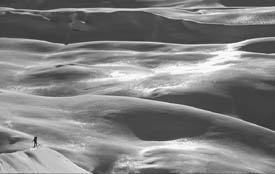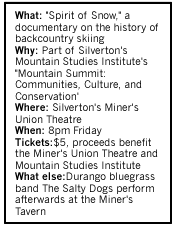|

|

written by Allen
Best
 Review:
‘Spirit of Snow' Review:
‘Spirit of Snow'
Backcountry skiers have a
vague sense that they, not the world of resorts, are the rightful
torchbearers for skiing. A new film, “Spirit of Snow,”
obliquely makes the case for this belief.
Opening scenes describe the
uphill huff amid scowling weather and hulking mountains that
backcountry skiers know so well. This is wilderness, the honored
earn-your-turns sequence, the richness of the sensory experience.
 Concluding
scenes show the payoff, the graceful swoops down slinky slopes,
silky light with powder. Mountain majesty and winter gruffness,
work and play, friendship and aloofness – all the ironies
and narcotics of backcountry skiing are there. Concluding
scenes show the payoff, the graceful swoops down slinky slopes,
silky light with powder. Mountain majesty and winter gruffness,
work and play, friendship and aloofness – all the ironies
and narcotics of backcountry skiing are there.
Ambitiously, filmmaker Dave
O’Leske tries to present this eulogy to backcountry skiing
while telling the history of skiing from cave-dwellers to condo-sellers.
It seems like trying to ski two trails at once, but belatedly
it makes sense.
His vehicle for this additional story is interviews with various
septuagenarians, octogenarians and even Vail’s 93-year-old
Inga Prime, a former ski instructor who vows to snowboard at
age 100. Representing the storied 10th Mountain Division, Earl
Clark notes that despite knowing little about avalanches, none
of the 14,000 men who skied among the mountains of Colorado’s
Camp Hale were killed by snow.
Deep ecologist Dolores LaChapelle
recalls the wondrous deep powder skiing at Alta, Utah, in the
1940s; avalanche forecaster Jerry Roberts describes the draw
of the San Juans; and Erik Schultz of Alta, Wyo., explains why
he sit-skis the backcountry after a couloir wreck paralyzed
his legs. Dick Durrance was among the world’s top skiers
in the 1930s, later became a noted filmmaker and also helped
build Alta, Sun Valley and Aspen into major resorts. Some people,
he confides, prefer the backcountry.
This is skiing’s irony.
To become more popular, the sport has steadily lowered the bar.
Technological changes, from lifts to shaped skis, have all sought
to make skiing attainable to every man. This is all the skiing
prowess money can buy. At its extreme, this attitude is reflected
in the use of helicopters, snowmobiles and still other contrivances
to ski at several dozen ski areas in a day. That feat rivals
those “dubious superlatives” that distinguish Kansas,
i.e. world’s largest ball of yarn and world’s deepest
hand-dug well.
Like backcountry skiing, this
film is a low-budget affair. O’Leske, a resident of Ridgway,
worked construction in Telluride and fished in Alaska to finance
this film. For two winters, he sweated his way above timberline
six days a week, the heavy camera on his back. He got no financial
grants and used no mechanical or motorized gear to gain backcountry
access.
From that sweat and passion
comes a cinematic tribute that conveys skiing at its purest.
At the Telluride MountainFilm Festival, where it premiered in
May, “Spirit of Snow” won a special juried award.
This is not ski porn, the snow equivalent of six crotch shots
a minute, a judge remarked. This is about the soul of skiing.
|

